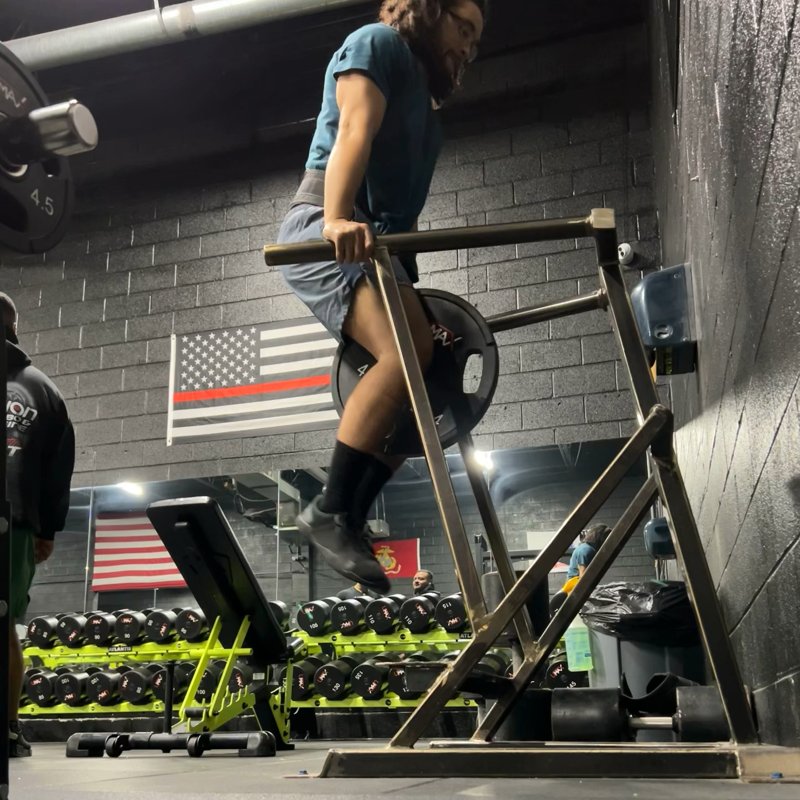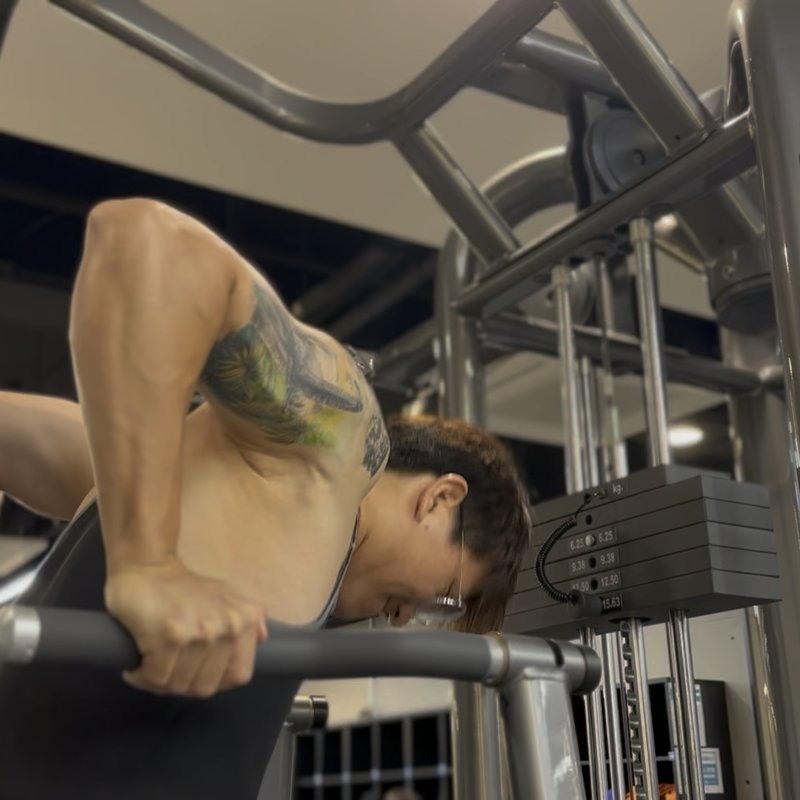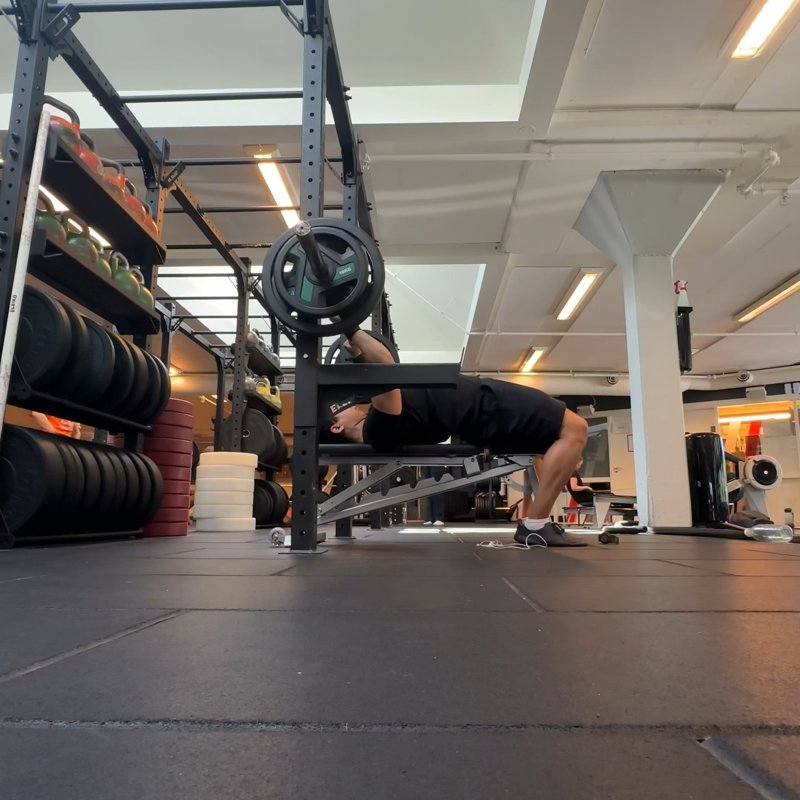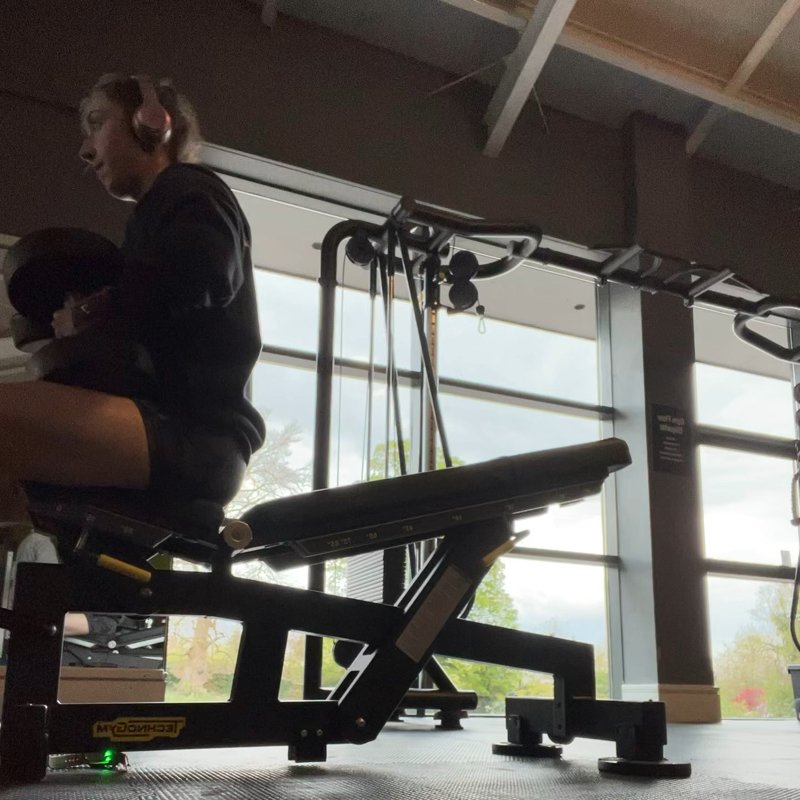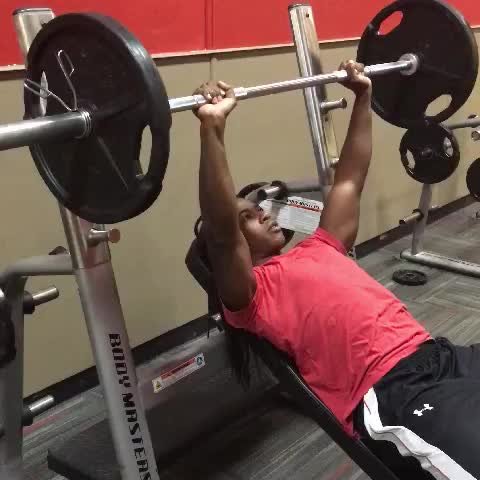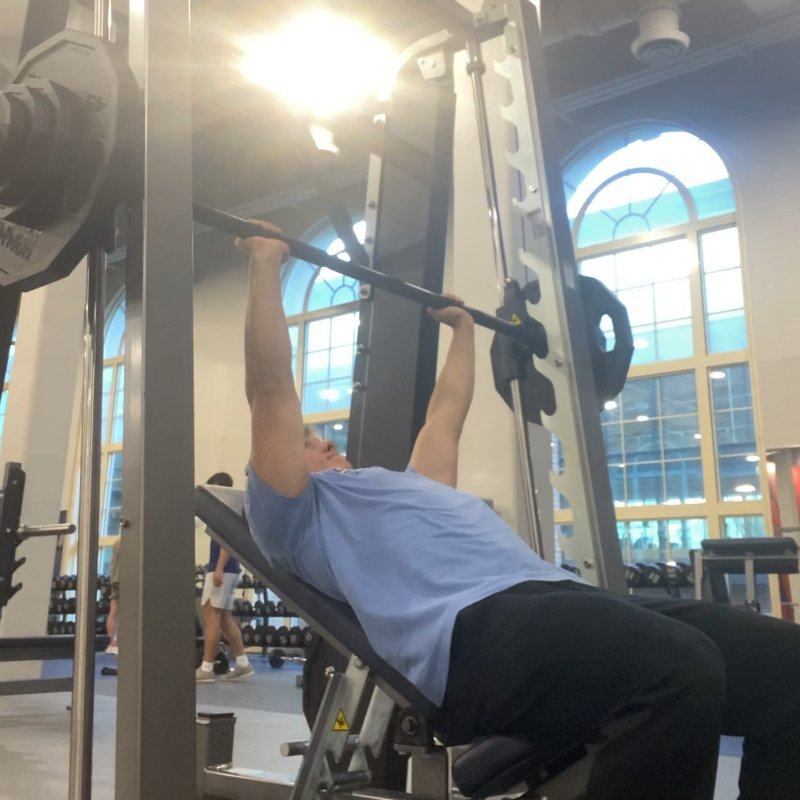Close-Grip Bench Press: The Ultimate Guide
The Close-Grip Bench Press is a compound exercise that emphasizes the triceps while also engaging the chest and shoulders by performing a bench press with hands positioned closer together than in the standard variation.
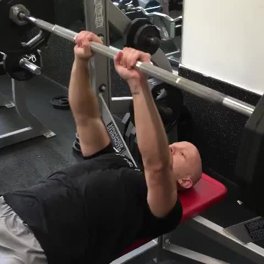
Quick Facts
Key Benefit
Enhanced tricep development with chest and shoulder engagement
Primary Muscles
Anterior Deltoids, Pectoralis Major, Triceps
Secondary Muscles
Abdominals, Forearms, Pectoralis Minor, Posterior Deltoids
Equipment
barbell, flat bench, power rack (optional)
Difficulty
Intermediate
Type
Compound
In This Guide
Ready to master the Close-Grip Bench Press?
Track your progress, see improvements over time, and build strength consistently.
Download GravitusThe Close-Grip Bench Press stands as one of the most effective compound exercises for developing tricep strength and size while simultaneously engaging the chest and shoulders. Unlike isolation movements that target the triceps alone, this variation of the traditional bench press distributes tension across multiple muscle groups while shifting primary emphasis to the triceps brachii through modified hand positioning.
What makes the Close-Grip Bench Press particularly valuable is its ability to load the triceps with significantly more weight than isolation exercises like pushdowns or extensions, creating a powerful growth and strength stimulus. The exercise effectively targets all three heads of the triceps muscle—the long, lateral, and medial heads—with particular emphasis on the lateral and medial heads that contribute significantly to arm thickness and pressing power.
Beyond tricep development, the Close-Grip Bench Press also serves as an excellent movement for enhancing lockout strength in the standard bench press, potentially helping lifters overcome sticking points in their pressing movements. Whether your goals include building bigger arms, improving pressing strength, or enhancing sports performance, this versatile exercise deserves a place in your training regimen.
Benefits of the Close-Grip Bench Press
The Close-Grip Bench Press offers several distinct advantages over both traditional bench press variations and isolation tricep exercises.
Comprehensive Tricep Development
Effectively targets all three heads of the triceps muscle with particular emphasis on the lateral and medial heads, contributing to overall arm thickness and definition.
Significant Loading Potential
Allows for heavier weight than isolation tricep exercises, creating greater mechanical tension—a primary driver of muscle growth and strength development.
Improved Lockout Strength
Enhances the final pressing phase of the standard bench press by strengthening the triceps, potentially helping lifters overcome common sticking points.
Shoulder-Friendly Pressing
The narrower grip position often creates less shoulder stress than wider grip variations, making it a valuable alternative for those with certain shoulder limitations.
Stability and Coordination
Challenges core stability and intermuscular coordination through the narrower base of support, developing functional strength that transfers to sport and daily activities.
Time Efficiency
As a compound movement, it effectively trains multiple muscle groups simultaneously, making it a time-efficient addition to any strength training program.
Proper Form & Technique
Setup
- Lie on a flat bench with your feet planted firmly on the floor.
- Position yourself so your eyes are approximately under the barbell.
- Grasp the barbell with hands positioned shoulder-width apart or slightly narrower (approximately 8-14 inches between hands).
- Ensure your grip is even on both sides, with thumbs wrapped around the bar (avoid a false/thumbless grip for safety).
- Pull your shoulder blades together and down, creating a stable base and slight natural arch in the lower back.
- Lift your chest slightly while maintaining contact between your head, upper back, and glutes with the bench.
Unrack and Starting Position
- Take a deep breath, brace your core, and unrack the barbell by straightening your arms.
- Move the bar horizontally until it's positioned directly over your lower chest/sternum.
- Keep your wrists straight, aligned with your forearms (avoid excessive flexion or extension).
- Maintain full-body tension with feet pressed into the floor and glutes engaged.
- Prepare for the descent by stabilizing the shoulder blades and maintaining proper bar position.
Descent
- Lower the barbell in a controlled manner by bending at the elbows.
- Keep your elbows closer to your body than in a standard bench press (approximately 45 degrees from your torso).
- Maintain wrist alignment and keep the bar path moving in a slight arc toward your lower chest/sternum.
- Continue lowering until the bar lightly touches your lower chest or sternum.
- Avoid bouncing the bar off your chest or allowing your elbows to flare excessively outward.
Press
- Press the barbell upward by extending your elbows, driving primarily through triceps engagement.
- Maintain the same bar path and elbow position established during the descent.
- Continue pressing until arms are fully extended but avoid forcefully locking out the elbows.
- Exhale gradually during the pressing phase, maintaining core tension throughout.
- Return to the starting position directly above your lower chest/sternum before beginning the next repetition.
Key Form Tips
Grip Width
Your grip should be shoulder-width or slightly narrower—too narrow can stress the wrists and elbows, while too wide shifts emphasis away from the triceps.
Elbow Path
Keep elbows at approximately a 45-degree angle to your torso—not flared wide or tucked extremely close.
Bar Path
Lower the bar to your lower chest/sternum rather than upper chest to optimize triceps involvement while reducing shoulder strain.
Wrist Position
Maintain straight wrists throughout the movement with the bar positioned at the base of your palm, not toward your fingers.
Back Position
Keep your shoulder blades retracted and depressed (pulled together and down) throughout the entire movement to provide stability.
Range of Motion
Touch the bar to your chest for full range of motion while avoiding excessive stretching at the bottom position.
Muscles Worked
Primary Muscles
- triceps: All three heads (lateral, medial, and long) of the triceps are heavily engaged as the primary elbow extensors during the pressing phase. The closer grip positioning emphasizes these muscles more than a standard bench press.
- pectoralis major: The chest muscles are significantly involved in the movement, particularly the lower and middle portions, though to a lesser extent than in a wide-grip bench press variation.
- anterior deltoids: The front shoulder muscles assist considerably in the pressing movement, helping to drive the weight upward alongside the triceps and chest.
Secondary Muscles
- pectoralis minor: The smaller chest muscle that lies beneath the pectoralis major assists in stabilizing the shoulder during the movement.
- serratus anterior: These fingerlike muscles along the side of the ribcage help stabilize the shoulder blade and assist in the pressing motion.
- posterior deltoids: The rear shoulder muscles act as stabilizers during the exercise, particularly during the lowering phase.
- abdominals: The abdominals, obliques, and lower back work isometrically to stabilize the torso throughout the movement, especially when pressing heavier loads.
- forearms: The muscles of the forearm are engaged to maintain grip on the bar and proper wrist positioning throughout the exercise.
Common Mistakes and How to Fix Them
Grip Too Narrow
Placing hands extremely close together (less than shoulder-width) increases wrist and elbow strain while providing no additional tricep activation benefits. Position hands approximately shoulder-width apart or just slightly narrower. Use the smooth rings on the barbell as reference points for consistent hand placement. This width allows for optimal tricep emphasis while maintaining joint health.
Excessive Elbow Flare
Allowing elbows to flare out wide (perpendicular to torso) shifts emphasis away from the triceps and increases shoulder stress. Keep elbows at approximately a 45-degree angle to your body throughout the movement. Think about tucking your elbows in without forcing them against your sides. Practice with lighter weights until you establish the correct movement pattern.
Bouncing the Bar
Using momentum by bouncing the bar off the chest reduces muscle activation and increases injury risk. Control the descent completely, pausing briefly when the bar touches your chest before pressing upward. Focus on a 2-1-2 tempo (2 seconds down, 1 second pause, 2 seconds up) to eliminate momentum and maximize muscle tension.
Lifting Hips Off Bench
Raising the hips off the bench creates an arch that shortcuts range of motion and reduces tricep involvement. Keep your glutes in contact with the bench throughout the entire movement. If you're struggling to maintain position, consider using slightly lighter weight or having a spotter provide feedback on your form.
Incorrect Bar Path
Lowering the bar to the upper chest or neck area reduces tricep involvement and increases shoulder stress. Direct the bar path to your lower chest/sternum area. Use a spotter to provide feedback on bar positioning until you develop consistency, or record your lifts from the side to check your bar path.
Wrist Hyperextension
Allowing wrists to bend backward (hyperextend) creates stress on the joint and reduces force transfer. Keep wrists straight and aligned with forearms throughout the entire movement. The bar should rest at the base of your palm, not in your fingers. Consider using wrist wraps if you struggle with maintaining proper position during heavier sets.
Exercise Variations
Equipment Variations
-
Smith Machine Close Grip Bench Press
Using a Smith machine to perform the movement, which provides a fixed bar path and can be beneficial for beginners or those training without a spotter.
-
Dumbbell Close Grip Bench Press
Performed with dumbbells held with palms facing each other, which can provide a more natural range of motion and greater stability challenge.
-

EZ Bar Close Grip Bench Press
Using an EZ curl bar rather than a straight barbell, which places the wrists in a more neutral position and may reduce wrist strain for some lifters.
-
Banded Close Grip Bench Press
Adding resistance bands to the barbell to create accommodating resistance, increasing tension at the top of the movement where the triceps are most active.
Angle Variations
-
Close-Grip Incline Bench Press
Performing the exercise on an incline bench (15-30 degrees), which shifts additional emphasis to the upper chest and anterior deltoids while still heavily targeting the triceps.
-
Decline Close-Grip Bench Press
Executing the movement on a decline bench, which places greater emphasis on the lower chest while maintaining significant triceps activation.
-

Floor Close-Grip Press
Performing the exercise lying on the floor instead of a bench, which reduces the range of motion but can be beneficial for those with shoulder issues or as a regression for beginners.
Specialty Variations
-

Close-Grip Board Press
Placing a wooden board or foam block on the chest to reduce range of motion and overload the lockout portion of the press, which emphasizes triceps even more.
-

Tempo Close-Grip Bench Press
Manipulating the lifting tempo (e.g., 3-second eccentric, 2-second pause at bottom, 1-second concentric) to increase time under tension for greater muscle development.
-
Close-Grip Pin Press
Setting safety pins in a power rack at chest level and pressing from a dead stop, eliminating the stretch reflex and increasing demand on the triceps for initiating the press.
-

Swiss/Football Bar Close-Grip Press
Utilizing a specialized multi-grip bar that allows for neutral grip positions, reducing wrist strain while effectively targeting the triceps.
Frequently Asked Questions
The Close-Grip Bench Press differs from isolation exercises like tricep pushdowns or extensions in several significant ways. As a compound movement, it allows for substantially heavier loading—typically 2-3 times the weight possible with isolation exercises—creating greater mechanical tension, a primary driver of strength and hypertrophy. This increased loading potential makes it particularly effective for building overall tricep strength and mass.
Additionally, the movement engages multiple muscle groups simultaneously (triceps, chest, shoulders, and core), making it more metabolically demanding and time-efficient. From a functional perspective, the pressing pattern has greater carryover to athletic movements and daily activities compared to isolation exercises.
However, isolation movements like pushdowns offer advantages in targeted muscle activation, mind-muscle connection development, and reduced technical complexity. For optimal tricep development, most advanced programs include both compound movements like the Close-Grip Bench Press for overall loading and isolation exercises for specialized development and metabolic stress, typically performing compounds first when energy and strength are highest.
The optimal hand spacing for the Close-Grip Bench Press is typically shoulder-width or slightly narrower, usually placing hands 8-14 inches apart. Contrary to some misconceptions, an extremely narrow grip (hands touching) is not necessary and can actually be counterproductive, placing excessive stress on the wrists and elbows without providing additional tricep activation.
The ideal width allows your forearms to remain vertical when viewed from the front at the bottom position, with elbows tracking at approximately a 45-degree angle relative to your torso. This positioning maximizes tricep engagement while minimizing joint strain.
Individual factors like arm length, shoulder width, and joint mobility will influence your optimal grip width. Experiment within the shoulder-width range to find the position that allows for comfortable wrist alignment, appropriate elbow positioning, and maximum tricep engagement. If you experience wrist or elbow discomfort, try widening your grip slightly or consider using an EZ bar or Swiss/football bar that places the wrists in a more neutral position.
Whether the Close-Grip Bench Press can replace the traditional bench press depends on your specific training goals. For overall chest development and maximal pressing strength, the traditional bench press typically remains superior due to its greater chest muscle activation and potential for absolute loading.
However, for programs prioritizing tricep development, the close-grip variation can certainly serve as the primary pressing movement for periods of 4-8 weeks. For powerlifters or those focused on maximizing bench press performance, the close-grip variation works best as an accessory movement rather than a replacement, as the motor patterns differ slightly from competition technique.
For bodybuilders or general fitness enthusiasts, cycling between traditional and close-grip as your primary pressing movement can provide novel stimulus and prevent plateaus. A balanced approach might include phases where close-grip is your main pressing movement, followed by phases returning to traditional bench press.
Regardless of which serves as your primary movement, most comprehensive programs include both variations in some capacity to ensure complete upper body development.
Generally, you should expect to use approximately 70-85% of your regular bench press weight when performing the Close-Grip Bench Press. The reduced weight is due to several factors: the mechanics of the close grip position decrease leverage advantage, there's less chest muscle recruitment to assist the movement, and the triceps (though strong) are smaller muscle groups than the chest.
Using weight that's too heavy typically leads to technique breakdown—elbows flaring out, wrists bending backward, or the grip gradually widening during the set—all of which reduce tricep emphasis and increase injury risk.
For most lifters, focusing on perfect execution with moderate weight (8-12 repetitions with challenging but manageable resistance) provides optimal tricep stimulus when first incorporating this exercise. As technique and strength improve, gradually work toward heavier loads in the 6-8 repetition range for portions of your training cycle.
Remember that the primary goal of this variation is targeted tricep development, not maximizing absolute weight moved, so prioritize proper form and muscle engagement over chasing numbers.
For many individuals with certain types of shoulder discomfort, the Close-Grip Bench Press can actually be more comfortable than the traditional wide-grip bench press. The narrower hand position typically reduces the degree of shoulder abduction and external rotation required, potentially decreasing stress on the anterior shoulder structures that commonly become irritated in pressing movements.
That said, the exercise's suitability depends entirely on the specific nature of your shoulder issue. For those with existing elbow or wrist problems, the close grip position might increase discomfort due to the altered joint angles.
If you have a diagnosed shoulder condition, consult with a physical therapist or sports medicine professional before incorporating this or any pressing movement. Several modifications can make the exercise more shoulder-friendly if needed: performing the movement on a slight incline (15-20 degrees), using the floor press variation to limit range of motion, employing specialized bars like the Swiss/football bar that allow neutral grip positioning, or implementing partial range of motion variations.
Always start conservatively with lighter weights to assess your body's response before progressing.
Video Demonstrations
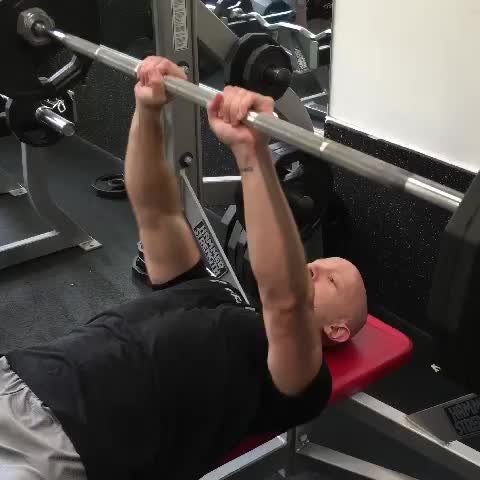
Log in to watch video demonstrations
Login to Watch3 video demonstrations available
Find more video demonstrations in the Gravitus app
Tips from the Community
-

Hands shoulder width. Elbows flare out only to a 30 degree angle don't tuck them in too much. Bar to stay a little below the nipple area. Squeeze scapulas together. They call it ticking them in your back pocket. Push yourself away from the bar not the bar away from you. This tends to keep the scapulas together?
-

Keep the elbows out and away from the body at the bottom of the movement to isolate your tris and inner chest.
-

For powerlifting I would suggest just going in a tiny tiny bit closer then how you typically press. Even for bodybuilding I don’t think going too close is safe. Shoulder width apart is the closest I’d say one should go.
Track your progress with Gravitus
Download Gravitus to log your workouts, track your progress, and join a community of fitness enthusiasts.

Helpful Resources
One Rep Max Calculator
Find your one rep max for any exercise without maximal testing. Essential for developing effective strength training programs.
Calculate 1RMWorkout Programs
Follow structured workout programs created by fitness professionals to maximize your strength and muscle gains.
View Programs